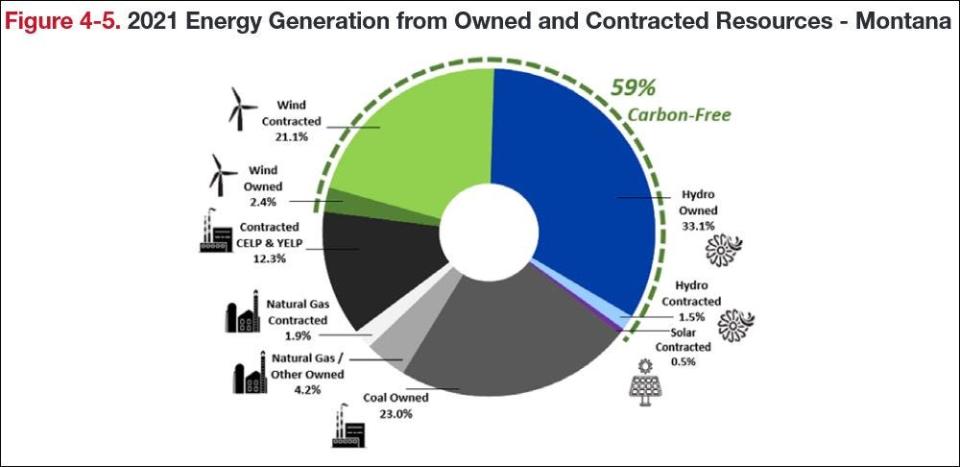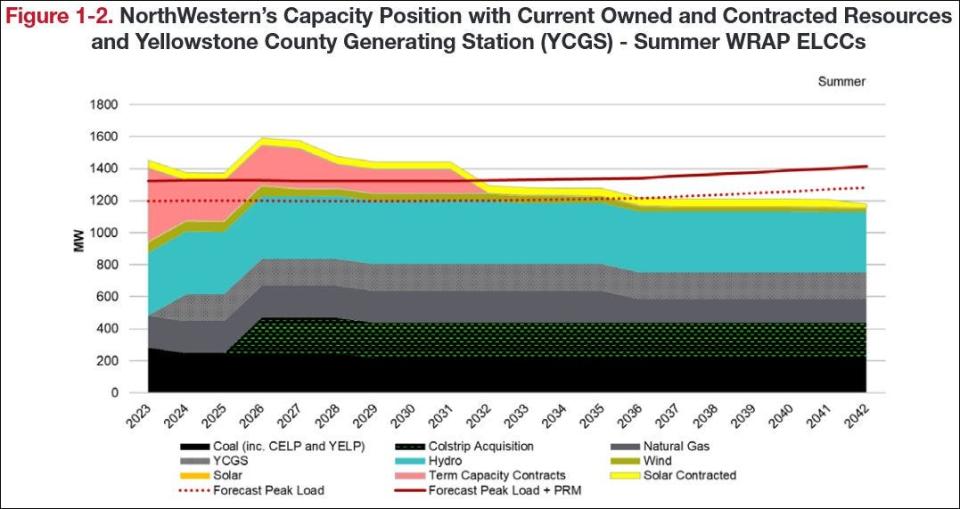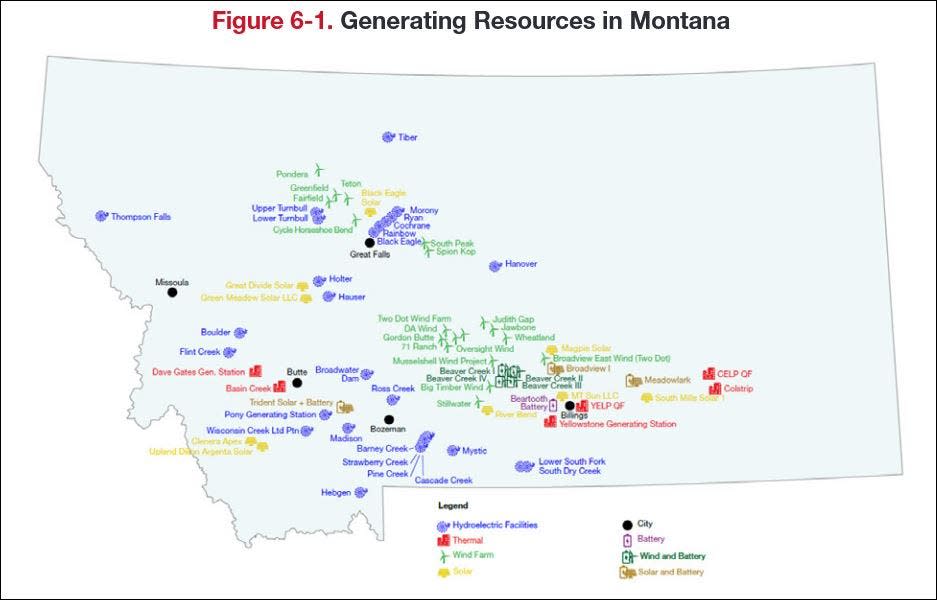NorthWestern Energy critiqued for reliance on coal, gas in its 20-year plan for Montana
Nearly four months ago NorthWestern Energy, Montana’s largest publicly owned utility, submitted its forecast for Montana’s energy supply needs for the next 20 years. NorthWestern’s Integrated Resource Plan (IRP) states that the utility is already contending with periodic electricity capacity deficits that regularly force NorthWestern to purchase expensive out of state energy resources and warns that the potential for the early closure of the Colstrip coal fired generating plant would make the electricity generation gap in Montana larger and more uncertain.
NorthWestern forecasts that the demand for electricity in Montana will continue to increase by 4% to 6% annually for the next 20 years, and that “the resources best suited to address NorthWestern’s needs are flexible natural gas generation and long-duration energy storage resources.”
“The Pacific Northwest is facing tight supply conditions which are expected to persist with projected coal retirements and a lack of adequate replacement power capacity resources,” the IRP states. “NorthWestern cannot count on continued energy imports to serve our customers reliably during peak demand given the risk of declining capacity generation in the region.”
NorthWestern’s IRP was the focus of a listening session held in Great Falls on Monday. The meeting was chaired by Public Service Commissioner Randy Pinocci and attended by PSC staff attorney Daniel Polkow.
The Montana Public Service Commission (PSC) regulates the rates and service quality for all investor owned electric and natural gas companies in Montana. Its primary mission is “to ensure that ratepayers have continued access to utility services that are affordable, reliable, and sustainable for the long-term.”
Neither Pinocci nor Polkow commented on NorthWestern’s IRP during Monday’s meeting, electing instead to simply listen and take note of public comments. Polkow noted at the beginning of the meeting that the plan itself does not select any new energy generating resources. Any proposed addition of energy generating capacity would occur through a competitive open bidding process.
Montana youth climate lawsuit a focus of attention
While Pinocci and Polkow had little to say, many of the 50 or more people who attended the listening session did. By coincidence, on the same day of the PSC’s first listening session, a Montana judge sided with 16 youth plaintiffs in Helena who argued that the State of Montana’s method of evaluating requests for fossil fuel permits is unconstitutional because it does not allow for agencies to consider the effects of greenhouse gas emissions.
The juxtaposition between Judge Kathy Seeley’s ruling and NorthWestern’s IRP was noted by several commenters at Monday’s listening session.
“That decision said that Montana is promoting fossil fuel usage to the detriment of our children,” commented Donna Gleves. "This plan … does not promote renewable energy, it does not do away with the Colstrip situation that we’re facing, it does not do away of the problems that were raised by this lawsuit.”
“The Montana court system clearly spelled out that we have an obligation to that generation,” said David Saslav, a representative of Citizens for Clean Energy, “to make decisions today that are not going to poison and hobble their ability to enjoy Montana’s clean and healthful environment, which is guaranteed to every Montana citizen by the state’s constitution.”

NorthWestern Energy representative Jo Dee Black noted that the company’s current energy portfolio includes a large number of carbon-free hydroelectric dams, wind farms and a small solar energy generating component. According to Black, approximately 58% of the energy NorthWestern produces comes from these clean energy resources, while national average for public utilities is around 40%.
Black added that NorthWestern has committed itself to only acquiring non-carbon emitting resources after 2035, and to achieving net-zero emissions by 2050.
NorthWestern Energy still reliant on fossil fuels
At the same time, NorthWestern retains partial ownership of the coal fired generating units in Colstrip, which represent more than 35% of the company's total generating capacity. NorthWestern is also constructing a new natural gas power station south of Laurel. The Yellowstone County Generating Station (YCGS) is scheduled to come online in 2024 and will add about 14% to NorthWestern’s total energy generating portfolio.
That seeming contradiction did not go unnoticed at the listening session.
“I’m concerned that the plan fails to fairly consider how to replace the Colstrip power plant with a low-cost mix of clean energy options, and instead proposes replacing it in the distant future with nuclear power,” commented Shannon Wilson, a retired environmental engineer. “Clean energy is one of the fastest growing industries in the world and well-designed clean energy projects can offer cost savings and increasingly attractive returns to the company that’s doing it.”
“A rapid shift to clean energy is not optional,” Wilson added. “Addressing climate impacts and catching up on clean energy later is going to be far more expensive. It’s not a ‘green’ thing it’s an economic thing.”

Black said that while NorthWestern Energy is committed to expanding its wind and solar resources in Montana, the intermittent nature of those energy sources they have to be blended with more reliable energy generating resources like electricity produced by burning coal and natural gas.
“Wind and solar are capable of providing low-cost energy but because they are so variable, they’re not always available to provide electricity when customers need it most, like after sunset on the coldest winter days in December and January," Black said. "Because wind and solar are variable and you can’t control when they generate, you have to have these other 24/7, on-demand capacity resources. If Colstrip were to retire and there isn’t an alternate resource available, then we’d be at an even greater capacity deficit in Montana.”
Black said that the gas-fired plant being built south of Laurel is part of the contingency plan to offset the energy loss if Colstrip’s remaining two generators and shut down after 2029. Majority owners Avista Corporation, Pacificorp, Portland General Electric and Puget Sound Energy are based in states phasing out coal generation by 2025 and 2030. NorthWestern Energy and Talen Energy, based in Pennsylvania, have said they want to continue their ownership in the facility.
“There is concern about transmission congestion to import energy during high demand times from out of state,” Black explained. “For example, in December when it was cold all across the state right before Christmas around 40% of the energy serving our customers was being imported from out of state, and it was also priced very high.
“In addition to that there is a real concern that as more regional coal plants and natural gas plants have been retired that there may not be energy on the market during an event like that,” Black continued. ”That’s exactly why NorthWestern Energy is securing more generation resources in the state."
Nuclear energy could be an option
Several other people at the Monday meeting asked why other energy generating systems are not being developed, including potentially building a nuclear power plant at the Colstrip site, or adding hydro-electric generators to Gibson Dam, west of Great Falls in the Rocky Mountain Front.
“I’d like to see some nuclear power put into that,” commented Ron Staley. “If we already have the generators there, we could probably retrofit those to accommodate nuclear generation.”
Staley’s sentiment was echoed in a letter from House Republican Lola Sheldon-Galloway.
“As a state legislator I have attended many conferences and gone on field trips acknowledging the vulnerability of electrical power across our nation, " Sheldon-Galloway said. "Montana once was a powerhouse producing our own energy with the ability to sell excess. Now due to the closure of Colstrip … we are in a less favorable situation. I believe we have two options for the commission to consider. Number one, replacement of the old power lines with more efficient and multi-use lines. Number two put in small nuclear plants along the power lines and use the cleanest, now safest energy production system.”
Black said that building some form of small, modular nuclear reactor is very real possibility in the future.
“There have been some recent changes to state law that mean that nuclear plants are an option in Montana right now,” she noted. “The technology is developing for these smaller modular nuclear plants, not the big plants from the past. We’re certainly looking at that option because nuclear does provide carbon free, 24/7 resources. It would be a steady source of electricity that can be relied upon when the wind isn’t blowing, or the sun isn’t shining. We’re absolutely looking at that as an option right now if it would be safe, reliable, and cost effective, but that technology is not running in the United States yet.”

Kathie Hansen suggested at Monday’s meeting that Northwestern consider generators at Gibson Dam.
“Gibson Reservoir has the capability of having turbines installed,” Hansen observed. “There are many of our waterways that could have water containment utilized to promote and make energy. It would be something that would be very cost effective.”
Former Cascade County Commissioner Jane Weber remarked that a hydro-electric generating capacity at Gibson Dam could conflict with the interests of Sun Valley irrigators.
“That would considerably impact our agricultural community in that neck of the woods,” Weber said. “The water in Gibson Reservoir is very seasonal. It drops down low in the summer. “I really don’t think it’s a viable source for hydro energy, except during the spring when we have a full Sun River flow. The rest of the season a lot of that water is used by our irrigators.”
As stated in the IRP, NorthWestern Energy’s immediate action plan is to continue to participate and develop partnerships with other regional energy suppliers, to press forward with completion of the Yellowstone County Generating Station and to keep a close eye on developments at the Colstrip coal fired generating plant.
This article originally appeared on Great Falls Tribune: Montana’s NorthWestern Energy critiqued for coal, gas reliance

